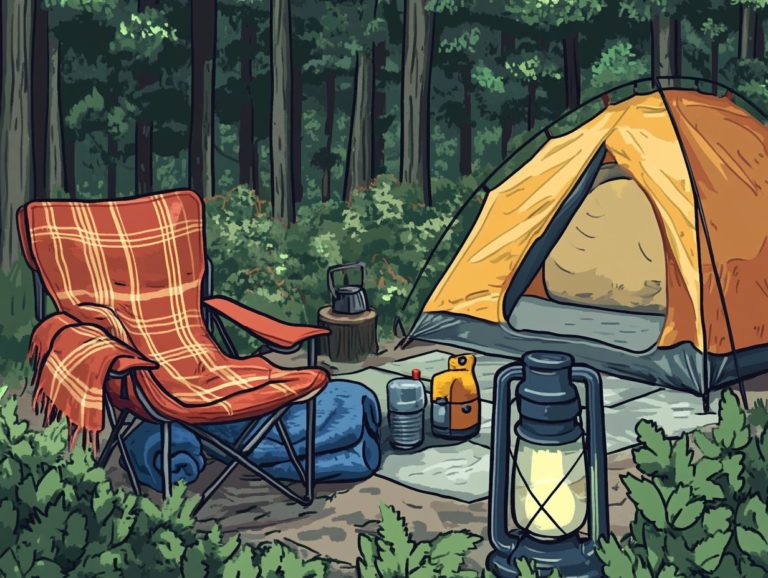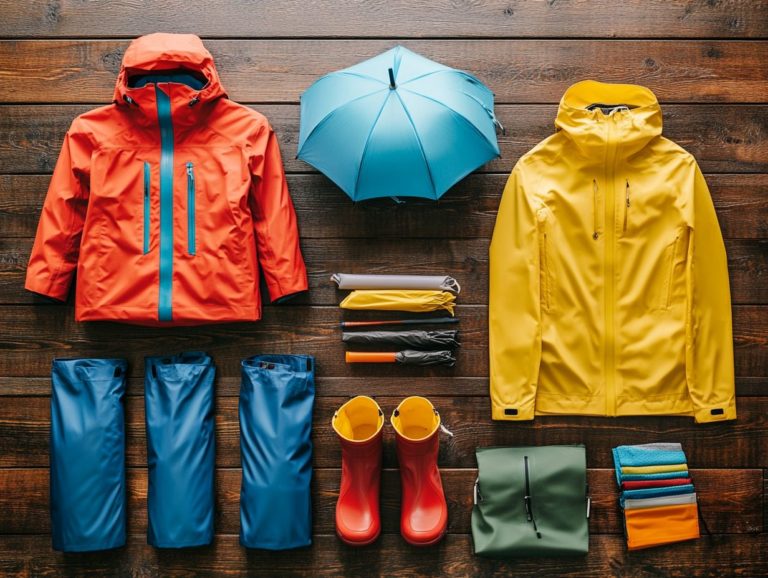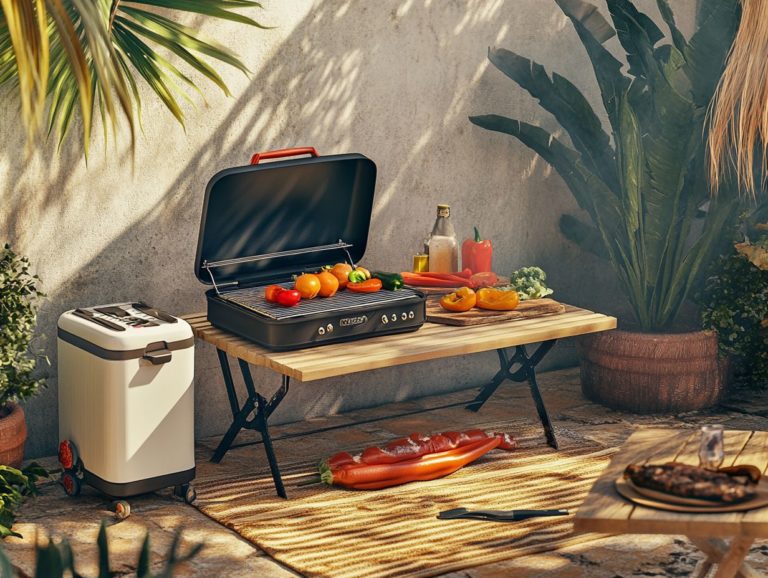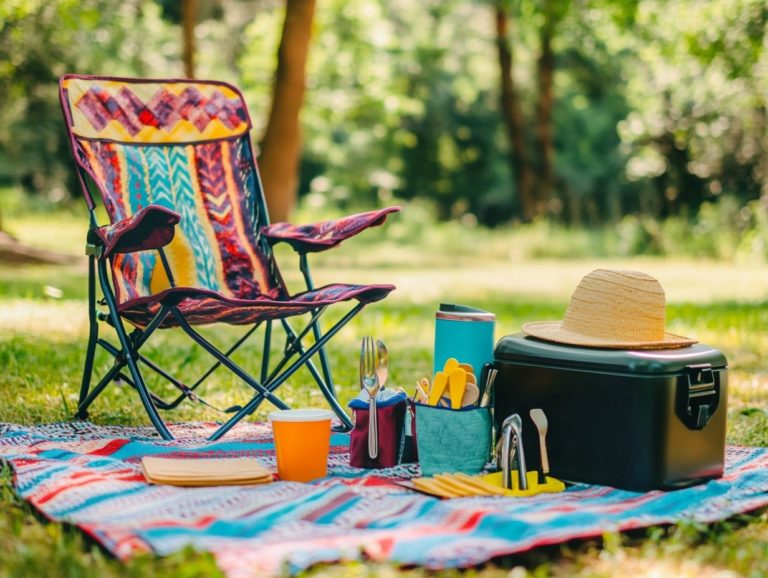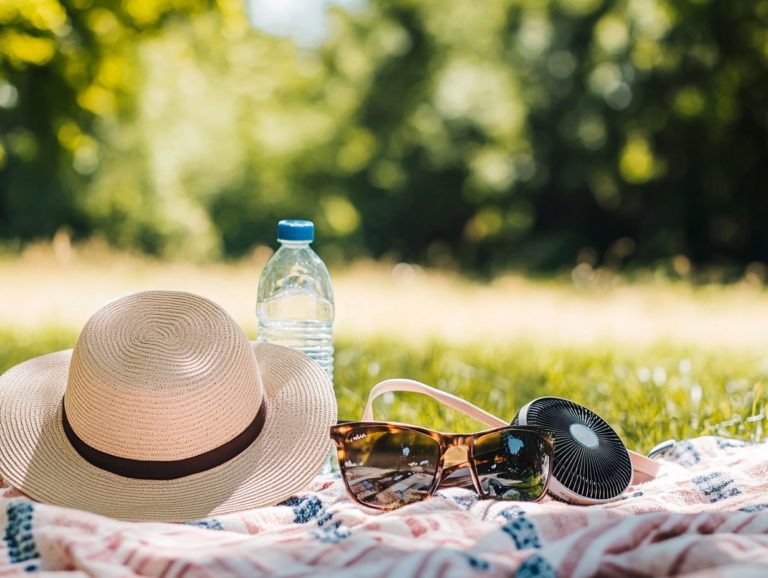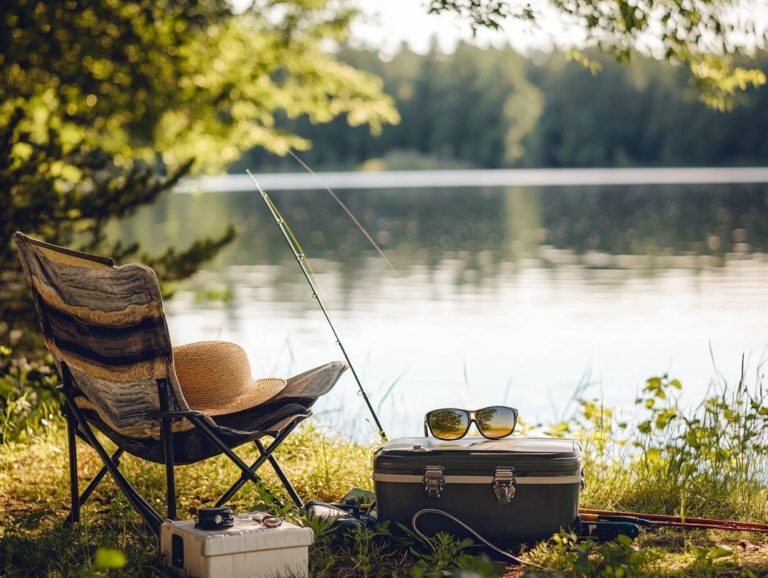The Best Safety Accessories for Outdoor Exploration
Planning an outdoor adventure? Whether you re hiking through scenic trails, camping under the stars, or delving into uncharted territories, the right gear can transform your experience from extraordinary to perilous.
This article delves into essential safety accessories that every outdoor enthusiast should consider, including navigation tools, protective gear, and emergency supplies. These items make your adventure better and keep you safe in unexpected situations. Arm yourself with both knowledge and quality gear, and venture into the great outdoors with unwavering confidence!
Contents
- Key Takeaways:
- 1. Must-Have Gear for Every Outdoor Adventure
- 2. Navigation and Communication Tools
- What Are the Best Navigation Tools for Outdoor Exploration?
- How Can Communication Tools Keep You Safe in the Outdoors?
- What Should You Consider When Choosing These Tools?
- Protective Clothing and Gear
- What Are the Must-Have Clothing Items for Outdoor Safety?
- How Do Protective Gear Protect You from Outdoor Hazards?
- What Are the Different Types of Protective Gear Available?
- 4. Emergency Supplies and First Aid Kits
- 5. Safety Tips for Using Outdoor Accessories
- Frequently Asked Questions
- What Are the Best Safety Accessories for Outdoor Exploration?
- Why Is a First Aid Kit an Essential Safety Accessory for Outdoor Exploration?
- How Can a GPS Device Improve Safety During Outdoor Exploration?
- Why Is It Important to Have a Map When Exploring the Great Outdoors?
- What Makes a Headlamp a Valuable Safety Accessory for Outdoor Exploration?
- Why Should I Carry a Whistle with Me During Outdoor Exploration?
Key Takeaways:
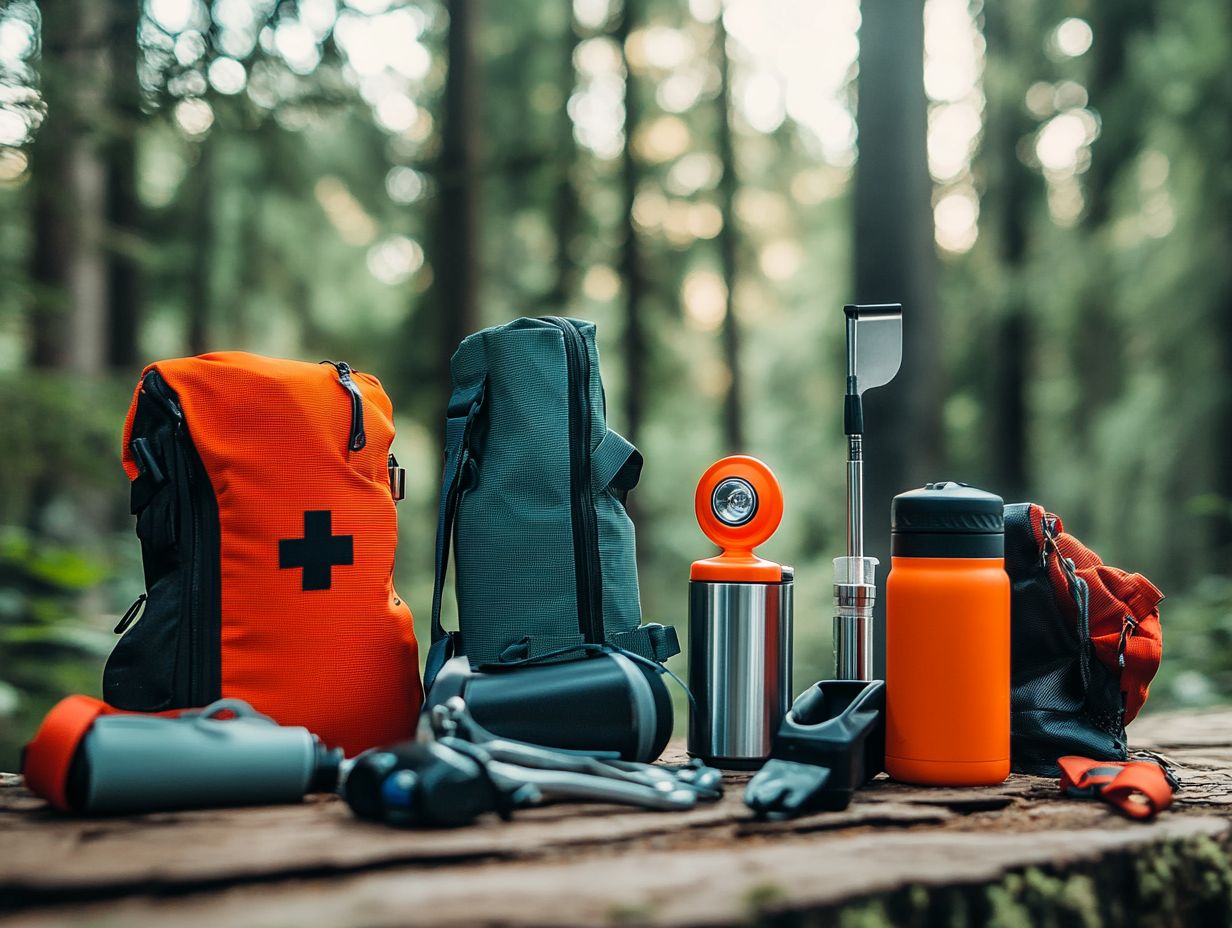
- Always carry essential safety gear like a first aid kit.
- GPS devices and satellite phones can save your life in emergencies.
- Protective clothing, like helmets and sunscreen, helps prevent injuries.
1. Must-Have Gear for Every Outdoor Adventure
When you embark on an outdoor adventure, equip yourself with must-have items like a first aid kit. This gear is crucial for your safety and enjoyment!
A durable tent provides shelter from unpredictable weather. Quality sleeping bags guarantee a restful night s sleep, no matter the temperature. Hydration packs keep you refreshed on the go! No more heavy water bottles!
Portable cooking equipment not only makes meal preparation a breeze but also fosters social connections around the campsite. Investing in the right gear helps you navigate outdoor environments confidently, greatly enhancing both your safety and enjoyment.
What Are the Essential Safety Accessories for Outdoor Exploration?
Essential safety accessories for your outdoor explorations include a well-stocked first aid kit, gear that protects you, like hats and sunscreen, and fire safety tools, such as fire extinguishers and fire blankets. These items are crucial for minimizing risks and ensuring a safe camping experience.
Having these accessories not only offers peace of mind but can also serve as lifelines in unexpected situations. A well-prepared first aid kit allows you to address common injuries think cuts, scrapes, or insect bites so you can manage minor ailments right on the spot.
Personal protective gear, especially hats and sunscreen, shields you from harsh UV rays, significantly reducing the risk of sunburn and long-term skin damage. Fire safety tools help control fires and keep you safe.
Together, these items create a powerful safety net, so you can fully embrace your adventurous spirit without worry!
Why Is It Important to Have This Gear?
Having the right gear is crucial for your safety and preparedness while camping! It not only elevates your experience but also significantly lowers the risk of accidents and bolsters your campsite security.
Statistics show that nearly 70% of camping injuries stem from inadequate preparation or a lack of essential equipment. In one famous case, a family faced hypothermia because they were unprepared for colder weather. This shows how vital it is to pack warm clothing!
Many accidents could be easily avoided with simple precautions. Investing in a quality first aid kit allows you to address minor injuries promptly. With the proper gear, you can fully embrace the great outdoors with confidence, knowing you re prepared for unexpected weather changes or wildlife encounters. This not only enhances your safety but also enriches your enjoyment of the adventure.
Get ready for your outdoor adventure today! Ensure you have the right gear and enjoy the great outdoors safely!
How Can These Gear Help in Emergency Situations?
In emergency situations, having the right gear can save lives. A well-stocked first aid kit allows you to address injuries promptly, while hydration packs ensure you have an adequate water supply.
It’s crucial to have fire safety equipment ready at hand to prevent or control fire hazards. Picture this: you twist an ankle on a rugged trail. A robust first aid kit, complete with elastic bandages and ice packs, gives you the power to administer quick treatment, helping to mitigate further injury.
When you’re navigating extreme heat, hydration packs equipped with built-in filtration systems guarantee you access to clean water, safeguarding you against dehydration.
In the face of wildfires, having fire extinguishers or fire blankets readily available not only protects you from immediate dangers but can also be critical for preserving structures and natural resources.
Every piece of specialized gear addresses unique challenges, ultimately making a significant difference in your survival and safety.
Effective navigation and communication tools are essential for your outdoor explorations. They ensure you can find your way safely while staying connected. By utilizing gear like a compass, GPS devices (Global Positioning System), and personal locator beacons, you greatly improve your safety in unpredictable environments.
Smartphone apps also play a vital role in modern camping adventures. A reliable GPS device shows your location instantly and tracks your route. A compass remains an irreplaceable ally for orientation, especially when visibility dips.
Personal locator beacons grant you peace of mind by allowing you to send distress signals in emergencies. Familiarize yourself with their operation before your trip and consider using them in tandem for a comprehensive safety strategy.
As you plan your outings, remember to check the battery life of your devices and pack extra power sources. This way, you’ll be prepared for assistance well into the night if the need arises.
The finest navigation tools for your outdoor adventures include reliable GPS devices, traditional compasses, and detailed maps each playing an essential role in ensuring you can navigate safely through various terrains.
While GPS offers the convenience of turn-by-turn directions, traditional navigation methods provide you with a deeper connection to the land, proving invaluable in areas where satellite coverage is scant. The latest GPS models, such as the Garmin GPSMAP series or the Suunto Traverse, are lauded for their durability and advanced features, including altimeters and storm alerts.
Don’t underestimate the classic compass or a meticulously crafted topographic map; they can often be more dependable in remote settings. Ultimately, combining these tools will likely provide the best solution for a safe and enriching outdoor experience.
How Can Communication Tools Keep You Safe in the Outdoors?
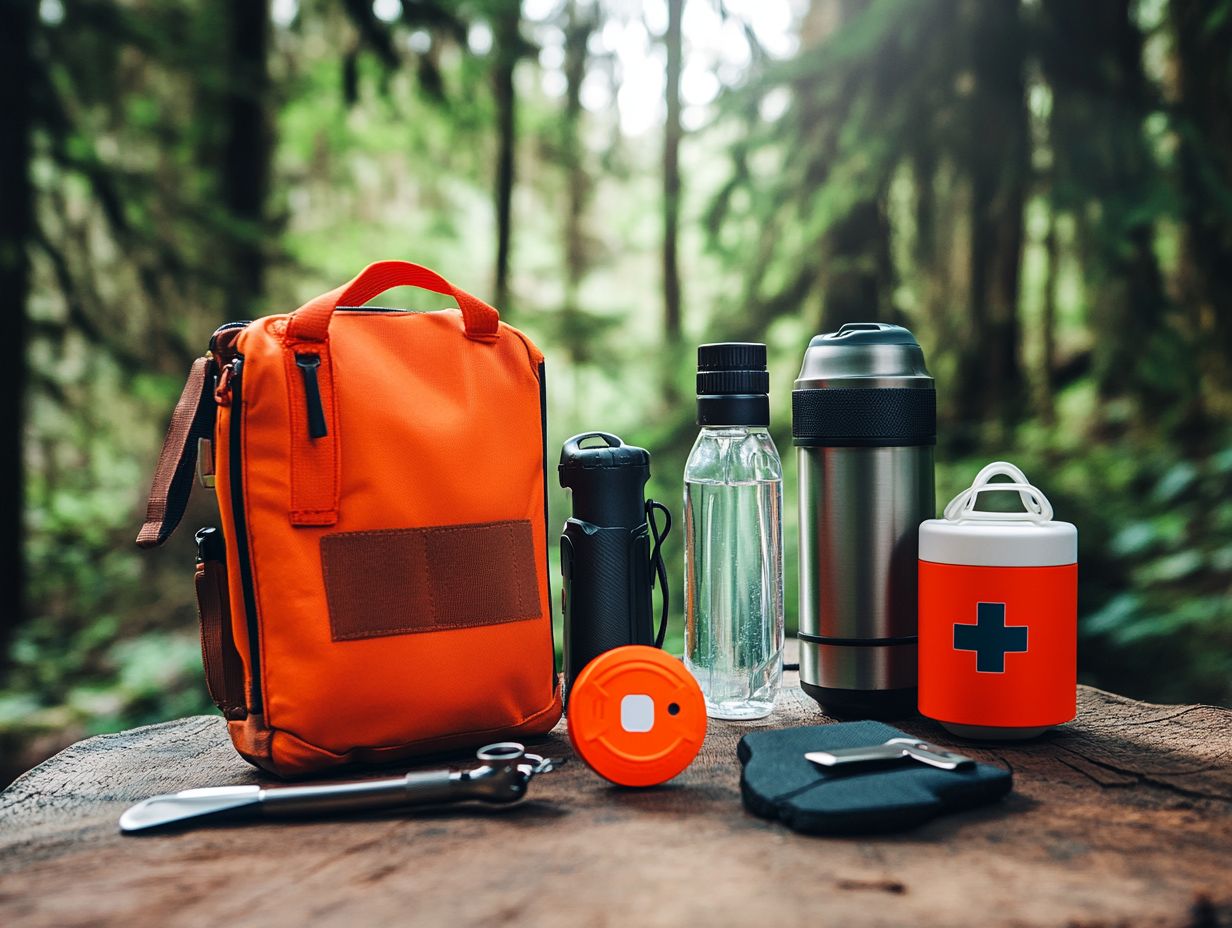
Communication tools like two-way radios and personal locator beacons are essential for enhancing your safety in the great outdoors. They allow you and your camping companions to stay in touch and quickly seek help during emergencies.
These devices keep you updated on weather shifts or navigational hazards and dramatically improve response times when unexpected situations arise. For example, if someone gets lost while hiking, a two-way radio enables your group to coordinate a plan swiftly, ensuring that no one ventures off alone.
Personal locator beacons, equipped with GPS technology, can instantly alert rescue teams to your precise location in the event of an accident, significantly boosting your chances of survival. With these communication tools at your side, whether you’re embarking on a simple day hike or a multi-day expedition, you’ll be well-prepared to handle whatever surprises may come your way.
What Should You Consider When Choosing These Tools?
When choosing navigation and communication tools for outdoor adventures, consider reliability, safety features, and ease of use. Pick equipment that matches your needs and the environment you’ll be in.
Durability is crucial; your tools must withstand whatever nature throws at them. Don’t overlook user-friendliness you want to operate the devices easily, even if you re not a seasoned pro.
Battery life and backup options are vital for boosting safety during lengthy excursions. Also, check how well your devices work with smartphones and GPS systems to enhance your navigation and communication.
Protective Clothing and Gear
When you venture into the great outdoors, wearing the right protective clothing is essential. Grab essential items like hats, sunglasses, sunscreen, and insect repellent to stay protected and enjoy every moment of your adventure!
Layering your clothing is key to adapting to changing weather. It allows you to add or remove layers as temperatures fluctuate.
Sturdy hiking boots provide the support and traction you need on uneven terrain. Fabrics that keep you dry enhance your overall comfort.
Personal protective gear like gloves and knee pads can save you during activities like rock climbing or mountain biking. Reflective vests improve visibility in low light, making your adventure safer and more enjoyable.
What Are the Must-Have Clothing Items for Outdoor Safety?
Must-have items include hats to shield you from the sun, sunglasses for eye protection, and sunscreen to prevent skin damage. Consider using GPS devices for navigation to keep track of your journey.
Lightweight long-sleeve shirts and pants protect against insect bites and UV rays, which is invaluable while hiking or camping. Sturdy footwear with good traction is crucial for navigating uneven terrains.
Windbreakers or waterproof jackets protect you from unpredictable weather, keeping you dry and comfortable. In cooler climates, thermal layers help retain body heat, adding safety to your adventure.
By thoughtfully selecting these items, outdoor enthusiasts can significantly enhance their protection and enjoyment with the help of top 10 hiking safety gadgets across various environments.
How Do Protective Gear Protect You from Outdoor Hazards?
Protective gear is essential for shielding you from outdoor hazards, including extreme weather, pesky insects, and potential physical injuries, ensuring that your adventures remain safe and enjoyable. Always remember to pack your camping stove for cooking meals safely outdoors.
Take insect repellent, for instance; it s a must-have for keeping mosquitoes and ticks at bay those little critters can carry diseases, after all. Armed with repellent, you can immerse yourself in nature without the nagging concern of bites.
Insulated clothing also plays a crucial role in keeping you warm in cold weather, significantly lowering the risk of hypothermia during those brisk nights.
By choosing sturdy footwear and helmets, you can navigate rough terrain or tackle activities like hiking and climbing without the fear of injury. Each piece of protective gear collaborates to minimize risks, paving the way for a more enjoyable and secure camping experience. Additionally, consider the top hiking gear accessories you need for further protection and convenience.
What Are the Different Types of Protective Gear Available?
You have a variety of protective gear at your disposal for outdoor safety, including insulated jackets, insect-repellent clothing, and safety footwear. Each piece is carefully made to offer specific protection against the environmental hazards you might encounter. Don’t forget to include a Global Positioning System (GPS) for effective navigation.
These items are essential for ensuring both comfort and security during activities like hiking, camping, or fishing. For example, insulated jackets keep you warm while you navigate frigid terrains, providing that much-needed warmth against extreme cold. Insect-repellent clothing serves as a reliable barrier against bothersome bugs, significantly reducing the risk of bites and allergic reactions.
Safety footwear, on the other hand, offers both traction and support on uneven surfaces while protecting you from sharp objects and potential injuries. By selecting the right gear, you can elevate your outdoor experience while effectively minimizing the risks associated with nature’s challenges.
4. Emergency Supplies and First Aid Kits
Having a well-stocked emergency supply kit, complete with a comprehensive first aid kit, is absolutely essential for your outdoor explorations. It gives you the power to respond effectively to injuries or unexpected situations, ensuring that safety remains at the forefront of your adventures in nature. Remember to include lighting equipment for emergencies.
To create an effective emergency supply kit, you should include key items such as:
- Water purification tablets
- Non-perishable food
- A flashlight with extra batteries
- First aid supplies like bandages and antiseptics
- A multi-tool
- A whistle to signal for help
Your first aid kit should be tailored to the specific activities you have planned. For example, if you’re going hiking, consider adding extra blister care items, while those engaging in water sports might want waterproof supplies these are items that can resist water damage, keeping essential supplies dry.
Customizing these kits not only addresses potential risks but also enhances your overall outdoor experience, granting you peace of mind as you immerse yourself in nature’s beauty. For those planning nighttime adventures, check out the best survival gear. Don’t wait until it’s too late; be prepared!
What Should Be Included in an Emergency Supply Kit for Outdoor Exploration?
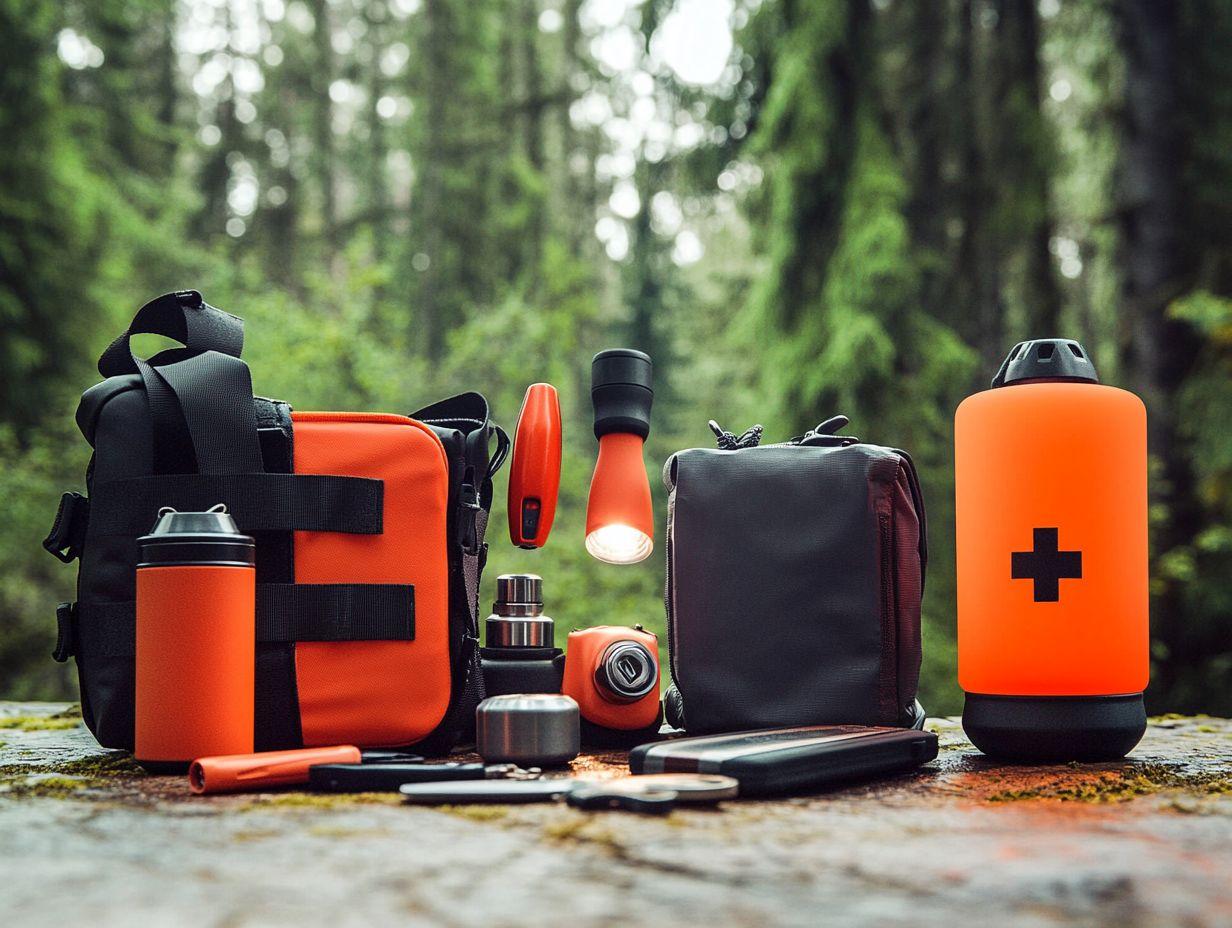
An emergency supply kit for outdoor exploration should be carefully chosen to include essential items like a first aid kit, hydration packs, emergency food, signaling devices, and tools for navigation and shelter such as GPS (Global Positioning System).
These items are absolutely essential for survival! They address immediate health and hydration needs while playing a crucial role in survival during unforeseen circumstances. A well-stocked first aid kit can tackle injuries ranging from minor cuts to serious emergencies, significantly enhancing your chances of survival. Hydration packs ensure you have access to clean water, while emergency food supplies sustain your energy levels in prolonged situations.
Signaling devices, such as whistles or mirrors, are critical for attracting attention. Meanwhile, navigation tools like compasses or maps are essential for safely exploring unfamiliar terrains. Don’t overlook the importance of a thermal blanket for warmth, which underscores the necessity of preparing for varying weather conditions.
Why Is It Important to Have a First Aid Kit?
A first aid kit is not just a luxury; it s an essential piece of your outdoor safety arsenal. It equips you with the necessary tools to treat injuries swiftly and effectively, possibly even saving lives in critical moments. A GPS device can also help you locate medical facilities if needed.
When you venture into the wilderness, you may encounter a range of injuries from minor cuts and scrapes to more serious issues like sprains, fractures, or allergic reactions. You might also find yourself dealing with pesky insect bites or the effects of heat-related illnesses.
Having a well-stocked first aid kit can make a world of difference in these situations, allowing you to provide prompt care and manage injuries effectively. Here are some essential items you should include:
- Adhesive bandages
- Sterile gauze
- Antiseptic wipes
- Tweezers for splinter removal
- Pain relievers
- A cold pack
A basic first aid manual offers invaluable guidance for tackling various emergencies, ensuring you feel prepared for whatever the great outdoors throws your way.
How Can You Customize Your First Aid Kit for Outdoor Activities?
Customizing your first aid kit for outdoor activities is essential to address your specific needs. Consider factors like the type of terrain, the duration of your trip, and any potential hazards that may arise during your adventure. Bringing GPS devices can also assist in navigating tricky terrains.
For example, if you’re hiking through rocky trails, it’s crucial to include blister treatment supplies and a snake bite kit. If you find yourself kayaking, packing waterproof bandages and motion sickness medication becomes wise, especially since water conditions can change dramatically.
When camping in remote areas, having supplies for treating insect bites and allergic reactions, along with a dependable method to purify water, can significantly enhance your experience. Each activity brings its own set of challenges, and tailoring your kit accordingly not only improves your safety but also boosts your confidence as you engage in these outdoor pursuits.
Prepare your kit today to ensure your outdoor adventures are safe and enjoyable!
5. Safety Tips for Using Outdoor Accessories
To maximize safety during outdoor adventures, it s vital to follow essential safety tips. This includes maintaining your equipment and adhering to fire safety practices.
Start by inspecting your gear before you set off. Ensure that your tents, sleeping bags, and cooking tools are in prime condition. Regular cleaning and proper storage can significantly extend the lifespan of these vital items. Always double-check that your fuel supplies for stoves are sufficient and that everything is functioning correctly before you hit the road.
When you arrive at your campsite, position your tents away from potential hazards like dead trees or large rocks. Avoid common pitfalls, such as neglecting to secure food properly to deter wildlife or overlooking local weather conditions. These simple precautions will enhance both your safety and enjoyment as you immerse yourself in the breathtaking beauty of the great outdoors.
What Are Some General Safety Tips for Outdoor Exploration?
General safety tips for outdoor exploration emphasize preparing for emergencies and understanding local wildlife. Maintaining your equipment ensures a safe and enjoyable camping experience.
Before you embark on your journey, familiarize yourself with the land and weather conditions. Check forecasts and be ready for any sudden changes in climate. Inform someone about your camping plans, including your expected return date, to enhance safety through accountability.
Having a well-stocked first aid kit and knowing basic methods for treating injuries can prove crucial in case of an injury. Keeping a vigilant eye on your food storage practices and using a food storage container will help you avoid uninvited animal guests, ensuring a more peaceful and secure camping experience.
How Can You Properly Use and Maintain Your Safety Accessories?
Proper use and maintenance of safety accessories is essential for their effectiveness. Regular checks, cleaning, and strict adherence to guidelines for equipment such as fire extinguishers and first aid kits are necessary. Don’t forget to ensure your camping gear is also in good condition.
To start, develop a routine that includes inspecting these items at predetermined intervals, like monthly or quarterly. During these inspections, be vigilant for any signs of damage, such as leaks or rust, especially in fire extinguishers and GPS devices. Keeping a clear record of these inspections fosters accountability and ensures timely replacements.
Regarding cleaning, always follow the manufacturer s instructions to prevent materials from degrading over time. Items like first aid kits and lanterns should be restocked regularly, ensuring that all supplies are current and functioning optimally. By maintaining a diligent approach, you can significantly enhance your safety preparedness.
What Are Some Common Mistakes to Avoid When Using This Gear?
When using outdoor gear, it is essential to avoid common mistakes, such as neglecting to check your equipment before heading out, forgetting to pack vital safety items, and not using fire safety gear correctly. Any of these could lead to dangerous situations. Always remember to include a reliable water filter for your hydration needs.
Many outdoor enthusiasts often overlook the importance of carefully planning their trips. This includes researching trail conditions and weather forecasts, which can significantly impact their overall experience.
It is crucial to ensure that your gear, including Global Positioning System (GPS) devices, is in perfect working order. Routine inspections can help prevent equipment failures that could dampen your adventure.
Consider packing a well-equipped first aid kit tailored to your specific outdoor activities, as this can greatly enhance your safety. It is also important to know how to use all your gear correctly and ensure appropriate insulation for your tents and sleeping bags.
By addressing these common pitfalls, you can significantly boost your chances of having a safe and unforgettable adventure in the great outdoors.
Frequently Asked Questions
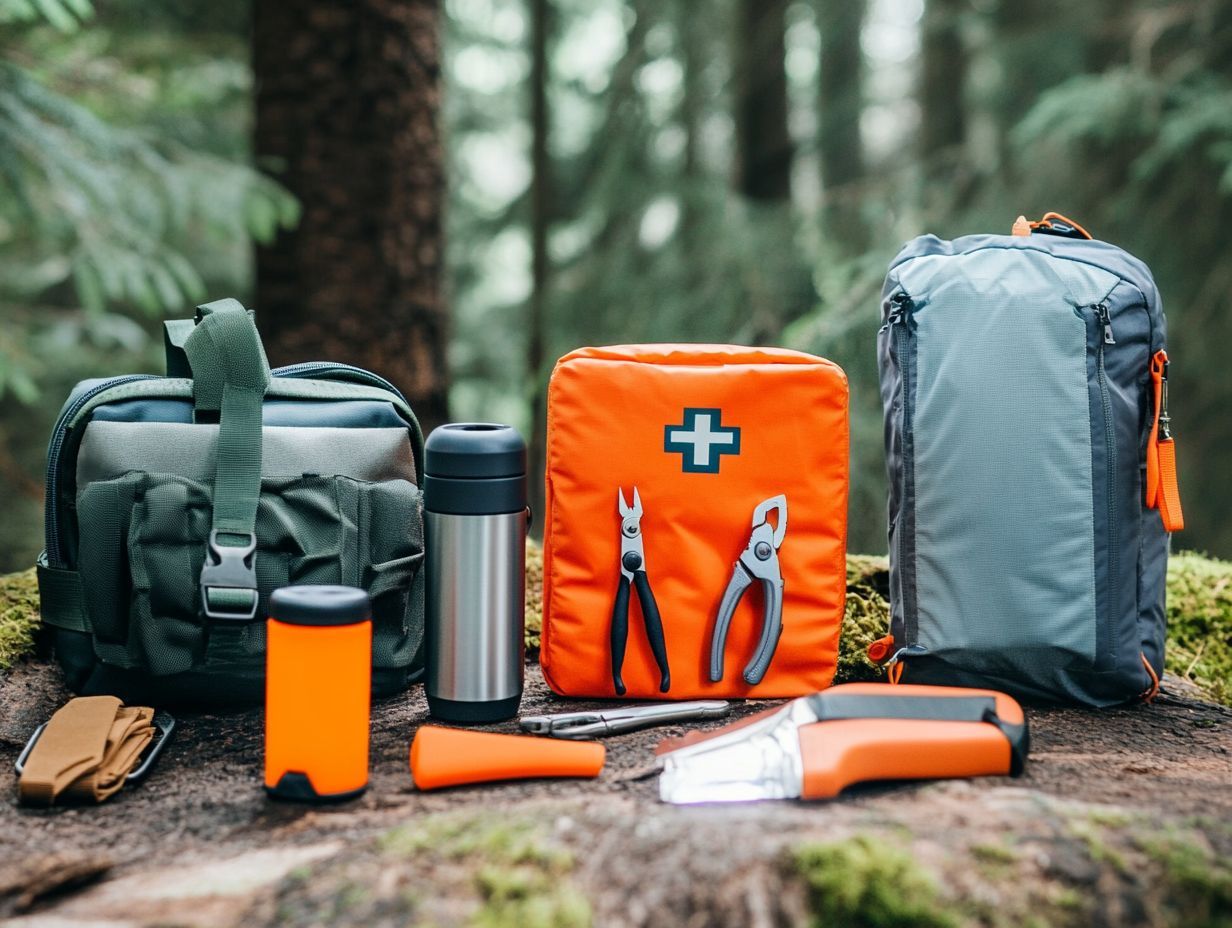
What Are the Best Safety Accessories for Outdoor Exploration?
The best safety accessories for outdoor exploration include a first aid kit, a GPS device, a map, a headlamp, a whistle, and a multi-tool, as well as reliable camping gear for various conditions.
Why Is a First Aid Kit an Essential Safety Accessory for Outdoor Exploration?
A first aid kit contains necessary supplies for treating minor injuries and illnesses during outdoor exploration. It can prevent small injuries from worsening.
How Can a GPS Device Improve Safety During Outdoor Exploration?
A GPS device helps you stay on track and navigate unfamiliar terrain during outdoor exploration. It can also be used to send a distress signal in case of an emergency.
Why Is It Important to Have a Map When Exploring the Great Outdoors?
A map provides important information about the area you are exploring, including potential hazards and alternate routes. It can also help you plan your trip more effectively.
What Makes a Headlamp a Valuable Safety Accessory for Outdoor Exploration?
A headlamp provides hands-free lighting, making it easier to navigate in low light conditions. It can also be used as a signal in case of an emergency.
Why Should I Carry a Whistle with Me During Outdoor Exploration?
A whistle is a simple yet effective tool for attracting attention in case of an emergency. It is also useful for communication among group members in noisy environments.
Gather your gear and prepare for your next outdoor adventure!

